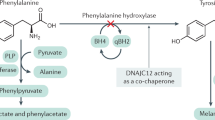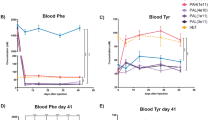Abstract
WE had previously established1 that the characteristic aberrations found in human phenylketonuria, namely, high plasma phenylalanine, phenylketones in the urine, and characteristic odour were observed in adolescent monkeys fed excessive amounts of L-phenylalanine in their diet. From the results of behavioural tests utilizing discrimination and maze performance, as well as poor adaptability to the test situation, thase monkeys appeared to be retarded in their learning ability. It seemed important to determine whether phenylketonuria could be produced in infant monkeys when the brain is apparently more sensitive to chemical insult. Long-term observation could then be made throughout the period of development and it might be possible to correlate the biochemical changes with behavioural patterns.
This is a preview of subscription content, access via your institution
Access options
Subscribe to this journal
Receive 51 print issues and online access
$199.00 per year
only $3.90 per issue
Buy this article
- Purchase on SpringerLink
- Instant access to full article PDF
Prices may be subject to local taxes which are calculated during checkout
Similar content being viewed by others
References
Waisman, H. A., Wang, H. L., Harlow, H. F., and Sponholz, R. R., Proc. Soc. Exp. Biol. and Med., 101, 864 (1959).
Udenfriend, S., and Cooper, J. R., J. Biol. Chem., 203, 953 (1953).
LaDu, B. N., and Michael, P. J., J. Lab. and Clin. Med., 55, 491 (1960).
Berry, J. P., and Woolf, L. I., Nature, 169, 202 (1952).
Harlow, H. F., Amer. Scientist, 47, 459 (1959).
Author information
Authors and Affiliations
Rights and permissions
About this article
Cite this article
WAISMAN, H., WANG, H., PALMER, G. et al. Phenylketonuria in Infant Monkeys. Nature 188, 1124–1125 (1960). https://doi.org/10.1038/1881124b0
Issue date:
DOI: https://doi.org/10.1038/1881124b0
This article is cited by
-
Excretion of Indolyl Acids in Phenylketonuric Monkeys
Nature (1963)



